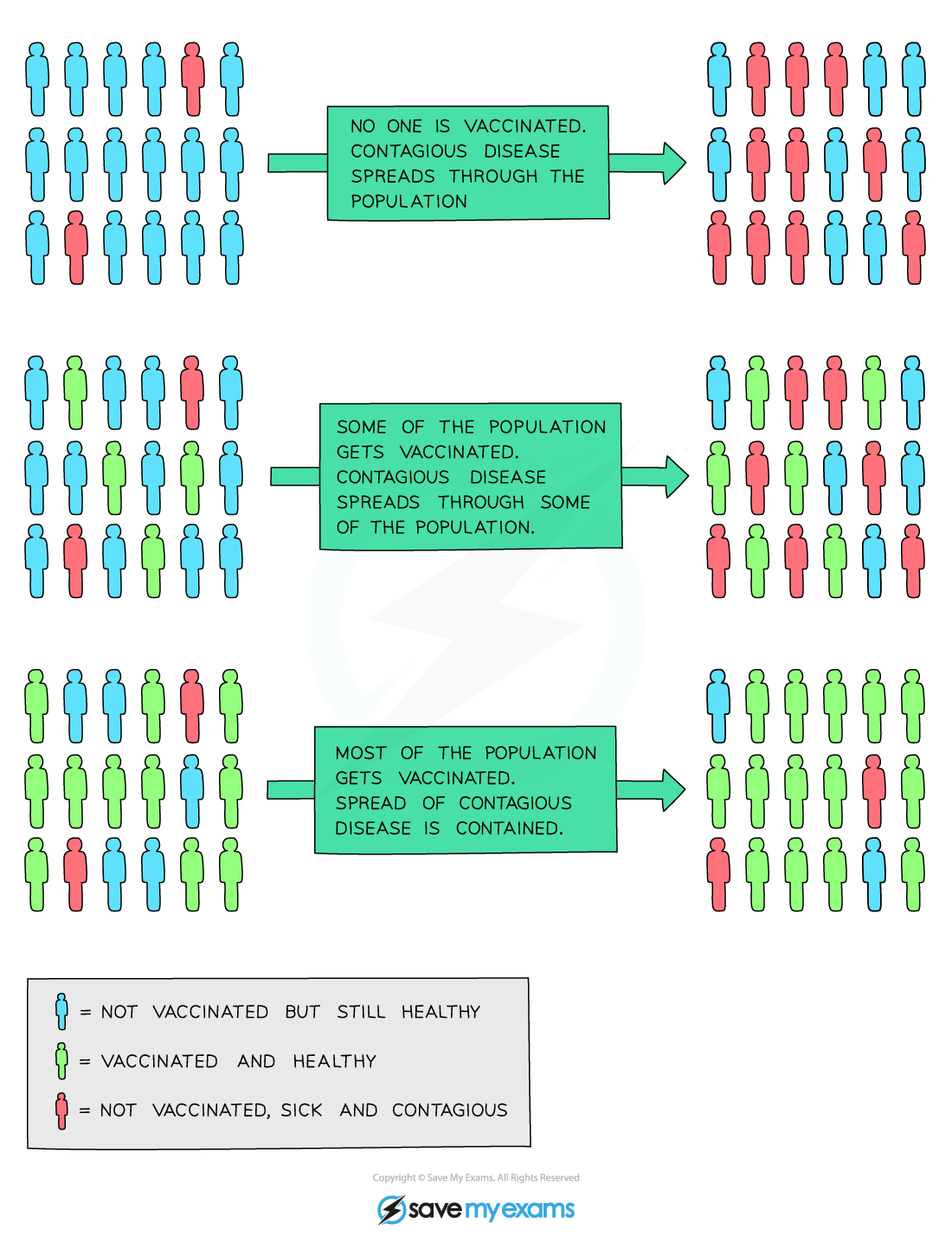Vaccines Against Disease (OCR GCSE Combined Science A (Gateway)): Revision Note
Exam code: J250
Vaccination
Vaccines are used to induce immunity to infectious diseases
A vaccine contains harmless versions of a pathogen
There are several different methods by which scientists ensure that vaccines contain harmless pathogens such as:
Killing the pathogen
Making the pathogen unable to grow or divide (attenuated vaccine)
Using fragments of pathogens, which include the necessary antigens (rather than whole cells)
A vaccine may be administered orally, nasally or via an injection
How vaccines work
Once in the bloodstream, the antigens contained within the vaccine can trigger an immune response in the following way:
Lymphocytes recognise the antigens in the bloodstream
The activated lymphocytes produce antibodies specific to the antigen encountered
Memory cells and antibodies subsequently remain circulating in the bloodstream

The process of long-term immunity by vaccination
Future infection by the same pathogen will trigger a response that is much faster and much larger compared to the initial response
Due to the rapid nature of the response, the pathogen is unable to grow in sufficient numbers to cause disease and the individual is said to be immune

The number of measles antibodies in the blood following vaccination. The secondary response is much faster and a greater number of antibodies are produced.
Other non-vaccine medicines: antibiotics, antivirals and antiseptics
Antibiotics are chemical substances produced by one microorganism that has a toxic effect on another, pathogenic organism
Antibiotics have been an important branch of medicine for decades since their discovery in the 1930s
They generally only work against bacterial pathogens (not fungi or viruses)
Penicillin is the first and best-known example
Antivirals are medicines that act against viruses only
It is difficult to target viruses without damaging host cells
A risk is that because viruses use host cell mechanisms to replicate themselves, damaging the virus may well inflict collateral damage on the host cell
Most antiviral drugs act by slowing the virus's rate of reproduction down
Can a virus be killed as it's debateable whether a virus is a living entity in the first place!
A well-known example is the anti-flu drug TMTamiflu
Antiseptics are products that kill microorganisms but are not drugs because they would be toxic if taken
They can be used externally eg. on the surface of the skin to clean wounds
Examples include TMLysol, a common laboratory antiseptic used to wipe surfaces before and after microbiological work, and common household antiseptics like bathroom cleaners
Advantages & Disadvantages of Vaccination
Why vaccinate?
Vaccination will prevent illness in an individual by providing artificial immunity
Vaccination involves exposing an individual to the antigens of a pathogen in some form, triggering an immune response which results in the formation of memory cells which can make antibodies against it
If a vaccinated individual is infected with the pathogen, they can destroy the pathogen before it becomes infectious
Consequently, vaccines reduce the likelihood that an infected individual will spread the pathogen they have been vaccinated against to others
If a large proportion of the population is vaccinated, it is unlikely that an unvaccinated individual will become infected with the pathogen
This is the principle behind the idea of herd immunity
There are three main scenarios with vaccination:
There are no vaccinations and the disease spreads quickly
Some of the population are vaccinated and the disease spreads to fewer people
Most of the population are vaccinated and this prevents the spread

Herd immunity protects the vulnerable that may not be able to have the vaccine
Worldwide vaccination
The role of the World Health Organisation (WHO) is to monitor global diseases, they will track if a disease is an epidemic (localised outbreak) or a pandemic (global outbreak)
For example, The WHO declared the COVID-19 outbreak a pandemic on 11 March 2020
The importance of vaccines cannot be underestimated:
The number of people with measles worldwide is increasing even though there is a vaccine
The increase is due to a drop in the vaccination rate globally
There was some controversy over the MMR vaccine in 1998 and the number of vaccinations dropped significantly after this
Vaccines have reduced the cases of diseases worldwide drastically
Vaccination Statistics Table

Data source: ourworldindata.org/vaccination
Advantages & Disadvantages of Vaccination Table

Examiner Tips and Tricks
Whatever your personal stance on vaccination, make sure you give a balanced view of the pros and cons of vaccination if asked to do so in an exam question.

Unlock more, it's free!
Did this page help you?